WMG News
WMG welcomes a senior delegation from China Energy
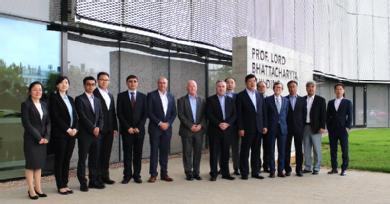 Professor David Mullins, Acting Head of WMG, was delighted to welcome Mr Li Dong, Executive Vice President of China Energy to WMG.
Professor David Mullins, Acting Head of WMG, was delighted to welcome Mr Li Dong, Executive Vice President of China Energy to WMG.
Mr Li Dong was accompanied by a senior delegation from China Energy and subsidiary companies China Shenhua Energy Co. Ltd - the largest coal company in the world, and Pujing Chemical Industry.
WMG’s Nanocomposites research team is currently working with colleagues at China Shenhua Energy Co. Ltd and Pujing Chemical Industry on the development of sustainable and environmentally friendly fully biodegradable plastics.
Dr Chaoying Wan and Professor Tony McNally updated the guests on the project, and the delegation toured other key WMG research facilities in Composites, Additive Layer Manufacturing (ALM), Metrology and Battery Technology.
Professor Tony McNally said: “At a time when the sustainability of single use plastics has become a global issue, the WMG partnership with China Shenhua Energy Co. Ltd and Pujing Chemical Industry is internationally leading. Our goal is to develop fully biodegradable plastics that decompose to benign components, such as water and, that can replace many of the single use plastics used in packaging.”
Do passengers prefer autonomous vehicles driven like machines or like humans?– research finds that “peeking round” corners provides answers
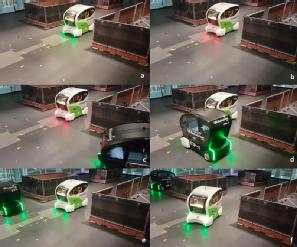 Passenger and pedestrian confidence and acceptance will be key to the future and development of autonomous vehicles so researchers at WMG at the University of Warwick have just conducted and reported an experiment to see which autonomous vehicles driving style engendered the highest levels of confidence among autonomous vehicles passengers – driving with full machine efficiency, or driving in a way that emulates average human driving. The surprising result was that neither was optimal but that a blend of both might be best.
Passenger and pedestrian confidence and acceptance will be key to the future and development of autonomous vehicles so researchers at WMG at the University of Warwick have just conducted and reported an experiment to see which autonomous vehicles driving style engendered the highest levels of confidence among autonomous vehicles passengers – driving with full machine efficiency, or driving in a way that emulates average human driving. The surprising result was that neither was optimal but that a blend of both might be best.
The researchers took 43 volunteers into a large warehouse designed to resemble a pedestrianised area in a town centre with a series of routes that included a range of junctions. Half were given 4 journeys around the route in an autonomous vehicle driving with full machine efficiency using all its capabilities to drive in as safe and efficient manner as possible while the others were given 4 journeys around the route in autonomous vehicles that tried to closely emulate average human driving patterns. They then scored the level of trust in the autonomous vehicles. The result has have just been published in the journal Information (2019, 10, 219; doi:10.3390/info10060219).
The overall result was that there was only a marginal difference in trust between the two driving methods. The efficient machine method was slightly favoured but even that small gap between the two driving styles narrowed over the four runs. What was noticeable for both the “machine” and “human“ driving styles is that confidence in both grew with each new round suggesting that simple familiarity and growing accustomed to the experience will be one of the most effective ways of quickly building trust and acceptance of autonomous vehicles once their use becomes more widespread.
|
Mean scores of trust |
Human |
Machine |
|
First Run |
59.30 |
63.19 |
|
Second Run |
59.55 |
66.33 |
|
Third Run |
65.85 |
68.29 |
|
Fourth Run |
67.20 |
69.38 |
Dr Luis Oliveira from WMG at the University of Warwick and the lead author on the paper said:
“The overall trust in both driving methods grew with every run. In the machine-like driving style this was steady upwards curve throughout the four journeys but in human-like behaviour there was a particularly steep change upwards in the scores between runs 2 and 3. The passengers in the experiment also acknowledged that future generations may be more comfortable with AVs and its features, as they learn to live with the new technology.”
The researchers also asked the participants to give some narrative about their experience and this showed that there were advantages on both modes of driving that may therefore need to be blended together in any future final package. The researchers’ literature review and warehouse experiment made clear that there re were two particularly clear lessons to be learned:
Smooth speed change – Past studies had already shown that Human drivers’ tendency is to break most at the start of any manoeuvre that requires deceleration whilst the totally automated driving programmes applied speed changes more gradually and efficiently. Human passengers preferred the comfort of the smoother changes of acceleration and deceleration provided by the machine driving methods.
Sharp turns - A common complaint was a feeling that the vehicles were performing uncomfortable and worrying sharp turns. This feeling was actually expressed by both those in the machine and Human style driving set ups but it was much more noticeable in the machine-like driving style condition. One typical negative comment was “what you’d expect from a driver is a bit of a gradual turn….there were moments where it was accelerating around corners, I think it catches you unaware.”
WMG’s Dr Luis Oliveira said:
“This shows that the challenge is that the speed and trajectory of autonomous vehicles should be finely controlled, but at the same time the vehicle should be assertive to provide the benefits of automated driving."
However it was the AV’s behaviours at junctions in the WMG University of Warwick warehouse test that produced the most diverse and surprising reactions.
The machine driven AVs were left to make use of all of their sensors and ability to communicate with vehicles that may out of line of sight to decide whether to enter a junction. If their sensors said it was safe and their communications with other vehicles indicated no approaching threats they would simply enter the junction without stopping. If however they detected a vehicle that they believed should have right of way – even if it was not yet visible to the human passenger they would stop and let that vehicle pass. In contrast The AV’s emulating human driving would always stop at a junction and would even edge into the junction as if the peek at what the oncoming traffic might be.
The reactions to those two different approaches were very varied and surprising.
Some liked the human approach with one saying that the AV was “…probably trying to inspire confidence in the passenger, I’m guessing, in terms of like the way it behaved, kind of quite similar to a human, it’s only ever going to inspire confidence I think it’s because that’s what we’re used to”.
Some also liked the machine driving approach of stopping at junctions even though there was no visible issue but because it was in communication with another out of sight vehicle that it perceived had right of way. One passage said: “it stopped at a junction, because I assume it knew that something was coming, as opposed to it reacting to seeing something coming”.
Equally there was dislike for both the human and machine driving methods of handling a junction.
Some perceived problems with the machine approach of just entering the junction if it believed it to be clear to do so with one saying that they were concerned about vulnerable road users. “..such as pedestrians or cyclists that could have been there that don’t communicate with the pod. That may be a safer way of doing it rather than flying around the corner”.
However others were greatly surprised at the “human” driving method AV stopping at every junction as they saw it not just as waste of the machines capabilities to scan and communicate ahead to understand traffic. They were frustrated that the vehicle was not “more assertive” One passenger saying “sometimes I didn’t expect it to stop, because I thought the other pod was a bit further away but then it did, so I guess it’s cautious…if I was driving I’d probably have gone”. Another passenger said “If I was in an autonomous pod with sensors giving a 360-degree view at all times, I’d expect the vehicle to instantaneously know whether it was safe or not, and not need to edge out”.
A further passenger who tested the human-like version, commented that a machine driving like a human and trying to look around the corners seemed ironically unnatural saying: “I think it was a bit unexpected because my expectation with the pods is that that there would be some un-naturalism to it rather than a human driver”.
Despite this seeming mass of contradictions in views about how AVs should handle junctions the research team do think there are valuable lessons to be learned even here. In particular:
- There is clearly a need to give the general public the details of the driving systems, for example, the recent technological features such as vehicle to vehicle communication
- For passengers in a vehicle consideration should be given to having a display and/or audio information that shares some of the information the vehicle is using so users can understand that the system is aware of hazards beyond the field of view.
- There may be some merit in presenting the full benefits of the most efficient methods of machine based driving progressively when mass use is first introduced, so that passengers can build confidence over time
Note for editors: The full list of authors on the paper is Luis Oliveira (corresponding authour), Christopher G. Burns, and Professor Stewart Birrell (all of WMG at the University of Warwick at time of publication of the journal article) and Karl Proctor of Jaguar Land Rover.
For further details please contact:
Luke Walton, International Press Manager
University of Warwick
L.Walton.1@warwick.ac.uk
+44 (0) 7823 362 150
Or
Peter Dunn, Director of Press and Media Relations
University of Warwick
Tel office: 024 76523708 UK +44 (0)24 76523708 International
Mobile/Cell: 07767 655860 UK +44 (0)7767 655860 International
Email p.j.dunn@warwick.ac.uk
Or
Lisa Harding, Head of Marketing and Communications, WMG,
University of Warwick Tel: 024 76 524721 or 07824 540845
email L.Barwick@warwick.ac.uk
WMG brings together key experts to discuss the future of transport
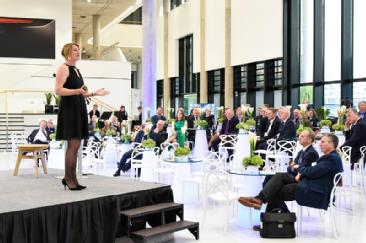 Last week, WMG High Value Manufacturing Catapult hosted an Autonomous, Connected, Electric and Shared (ACES) networking dinner in partnership with NatWest and Lombard.
Last week, WMG High Value Manufacturing Catapult hosted an Autonomous, Connected, Electric and Shared (ACES) networking dinner in partnership with NatWest and Lombard.
The event brought together CEOs, CTOs and senior executives from UK leaders in the sector, speakers included Jaguar Land Rover, Aston Martin, Rolls Royce, GiffGaff, WMG, You.Smart.Thing and FiveAI, to discuss how ACES technologies will radically change the way we travel.
There is a global call to both reduce emissions and also to ease congestion and increase the simplicity, safety and speed at which passengers are able to get from point A to B. There is no doubt that the future of transport will be ACES.
The UK has always been at the forefront of transport innovation and manufacturing, and needs to continue to bring manufacturers and governing bodies together to push forward the ACES transport agenda and ensure the UK remains competitive in a global market.
WMG, NatWest and Lombard will be releasing thought leadership pieces from expert industry leaders, sharing the challenges and opportunities for the UK transport sector.
Click here to read the Natwest article
For more information or to get involved please contact: wmgbusiness@warwick.ac.uk
WMG staff begin 5 day marathon cycle in memory of Coventry boy with rare cancer
 Nine staff from WMG at the University of Warwick have come together in a sponsored cycle marathon starting Tuesday 2nd July with the aim to raise £1,000 towards the total of £50,000 for charities researching a rare cancer called Alveolar Rhabdomyosarcoma, in memory of Ben Crowther, the young son of a WMG member of staff Scott Crowther, who died earlier this week.
Nine staff from WMG at the University of Warwick have come together in a sponsored cycle marathon starting Tuesday 2nd July with the aim to raise £1,000 towards the total of £50,000 for charities researching a rare cancer called Alveolar Rhabdomyosarcoma, in memory of Ben Crowther, the young son of a WMG member of staff Scott Crowther, who died earlier this week.
The plan is to cycle from WMG at the University of Warwick to the partner centres of the UK-wide High Value Manufacturing (HVM) Catapult network. All of the “Pass the Smile for Ben” cycle team will cycle cycling 90 miles to the next HVM centre, AMRC in Sheffield. Two of the riders Benjamin Silverstone and James Black will continue for a full five days finishing at Glasgow on Friday 5th July.
The funds raised by the race and/or donated to Ben and charities researching Alveolar Rhabdomyosarcoma via this fundraising page
https://www.gofundme.com/f/wmg-hvmc-cycle-challenge
will go directly to research for Rhabdomyosarcoma.
The team will leave the WMG concourse, on the University of Warwick campus, on their marathon cycle ride at 8:30am on Tuesday 2nd of July.
Archie MacPherson presents at key ERC conference
Archie MacPherson, CEO of the High Value Manufacturing (HVM) Catapult at WMG is part of the expert panel at the Enterprise Research Centre (ERC)’s State of Small Business Britain Conference 2019, taking place at The Shard in London today.
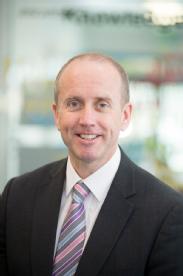 Archie joins automotive experts as well as representatives of the FSB and officials from the Department of Business, Innovation and Industrial Strategy, to discuss how to strengthen key sectors of the economy.
Archie joins automotive experts as well as representatives of the FSB and officials from the Department of Business, Innovation and Industrial Strategy, to discuss how to strengthen key sectors of the economy.
He explains: “Support is needed now, more than ever, from the High Value Manufacturing Catapult to ensure that UK businesses maintain competitiveness during this period of uncertainty in UK Manufacturing.”
The ERC’s State of Small Business Britain report, which was launched at the Conference, presents a new analysis of the fortunes of the manufacturing and services sectors since the Great Recession of a decade ago.
The report provides a broader snapshot of the health of UK manufacturers in light of recent announcements about factory closures and job losses by the carmakers Ford at Bridgend and Honda at Swindon which the Society of Motor Manufacturers and Traders (SMMT) has estimated could lead to the loss of 60,000 jobs directly and in supply chains. In May, British Steel collapsed into administration after a last-ditch appeal to the Government, putting a further 25,000 jobs at risk.
Following the Conference, Archie will be making his way back to WMG for “The Future will be Autonomous, Connected, Electric and Shared (ACES)” networking dinner bringing together global leaders in the transport and communications sector. Guests will discuss the opportunities and challenges that ACES technology can bring.
ENDS
About High Value Manufacturing (HVM) Catapult at WMG
WMG is one of the founding members of the High Value Manufacturing Catapult (HVMC), and the lead centre for Vehicle Electrification and Connected and Autonomous Vehicles (CAV) within the HVMC network. The centre is also active in showing how Digital Manufacturing technologies can help improve company and supply chain competitiveness.
As part of the £640m Government funding package for HVM Catapult, WMG was allocated £100m in 2018 to continue strengthening UK industry through collaborative R&D, innovation and technology transfer from automotive into other transport sectors over the next five years.
About the Enterprise Research Centre
ERC is the UK’s leading independent research institute on the drivers behind the growth and productivity of small and medium-sized enterprises (SMEs). It is funded by the Department for Business, Energy and Industrial Strategy (BEIS), the Economic and Social Research Council (ESRC), Innovate UK, The Intellectual Property Office (IPO) and the British Business Bank (BBB).
ERC is producing the new knowledge around SMEs that will allow us to create a business-friendly environment nationwide, grounded in hard evidence. We want to understand what makes entrepreneurs and firms thrive so we can spread the lessons from best practice and make the UK a more successful economy.
The Centre is led by Professors Stephen Roper of Warwick Business School and Mark Hart of Aston University, Birmingham. Our senior researchers are world-class academics from both Aston and Warwick Universities as well as from our partner institutions which include Imperial College, Queens University Belfast and the University of Strathclyde.
Professor Lord Bhattacharyya Lifetime Achievement Award presented to Lancaster University technician
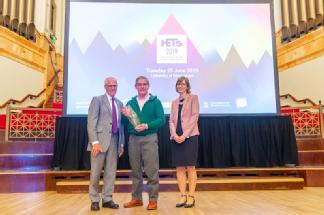 Yesterday (Tuesday 25th June) Jane Coleman, Chief Operating Officer at WMG, presented John Baum from Lancaster University with the Professor Lord Bhattacharyya Lifetime Achievement Award for Technical Excellence, at the Papin Prize Awards at The Higher Education Technicians Summit.
Yesterday (Tuesday 25th June) Jane Coleman, Chief Operating Officer at WMG, presented John Baum from Lancaster University with the Professor Lord Bhattacharyya Lifetime Achievement Award for Technical Excellence, at the Papin Prize Awards at The Higher Education Technicians Summit.
The Professor Lord Bhattacharyya Lifetime Achievement Award recognises continued excellence and/or significant achievements across an individual's technical career.
John was given the award for his strong commitment to Chemistry outreach, running activities for over 1000 kids and members of the community. He has been a lab technician since 1978 in Higher Education and industry. His nominator commented that “his devotion to outreach is outstanding, working weekends and long hours to prepare.”
The Summit is the largest event held specifically for UK Higher Education technical staff with sessions focused on technical skills and education including the importance of technical skills in driving forward innovation, and current initiatives to ensure the future provision of technical education to young people.
Professor Lord Bhattacharyya was passionate about tackling the UK’s skills shortage and highlighting the important role of technicians in contributing to internationally-leading education and research. He also recognised their role as ambassadors for science and engineering.
The Summit, hosted by Midlands Innovation in collaboration with Science Council, took place at the University of Birmingham. Find out more about the awards here.
How you charge your mobile phone could compromise its battery lifespan
Researchers at WMG at the University of Warwick have found that use of inductive charging, whilst highly convenient, risks depleting the life of mobile phones using typical LIBs (Lithium-ion batteries)
Consumers and manufacturers have ramped up their interest in this convenient charging technology, abandoning fiddling with plugs and cables in a favour of just setting the phone directly on a charging base.
Standardisation of charging stations, and inclusion of inductive charging coils in many new smartphones has led to rapidly increasing adoption of the technology. In 2017, 15 automobile models announced the inclusion of consoles within vehicles for inductively charging consumer electronic devices, such as smartphones – and at a much larger scale, many are considering it for charging electric vehicle batteries.
Inductive charging enables a power source to transmit energy across an air gap, without the use of connecting wire but one of the main issues with this mode of charging is the amount of unwanted and potentially damaging heat that can be generated. There are several sources of heat generation associated with any inductive charging system – in both the charger and the device being charged. This additional heating is made worse by the fact that the device and the charging base are in close physical contact, any heat generated in one device may be transferred to the other by simple thermal conduction and convection.
In a smartphone, the power receiving coil is close to the back cover of the phone (which is usually electrically non-conductive) and packaging constraints necessitate placement of the phone’s battery and power electronics in close proximity, with limited opportunities to dissipate heat generated in the phone, or shield the phone from heat generated by the charger. It has been well-documented that batteries age more quickly when stored at elevated temperatures and that exposure to higher temperatures can thus significantly influence the state-of-health (SoH) of batteries over their useful lifetime.
The rule of thumb (or more technically the Arrhenuis equation) is that for most chemical reactions, the reaction rate doubles with each 10 °C rise in temperature. In a battery, the reactions which can occur include the accelerated growth rate of passivating films (a thin inert coating making the surface underneath unreactive) on the cell’s electrodes. This occurs by way of cell redox reactions, which irreversibly increase the internal resistance of the cell, ultimately resulting in performance degradation and failure. A lithium ion battery dwelling above 30 °C is typically considered to be at elevated temperature exposing the battery to risk of a shortened useful life.
Guidelines issued by battery manufacturers also specify that the upper operational temperature range of their products should not surpass the 50−60 °C range to avoid gas generation and catastrophic failure.
These facts led WMG researchers to carry out experiments comparing the temperature rises in normal battery charging by wire with inductive charging. However the WMG were even more interested in inductive charging when the consumer misaligns the phone on the charging base. To compensate for poor alignment of the phone and the charger, inductive charging systems typically increase the transmitter power and/or adjust their operating frequency, which incurs further efficiency losses and increases heat generation.
This misalignment can be a very common occurrence as the actual position of the receiving antenna in the phone is not always intuitive or obvious to the consumer using the phone. The WMG research team therefore also tested phone charging with deliberate misalignment of transmitter and receiver coils.
All three charging methods (wire, aligned inductive and misaligned inductive) were tested with simultaneous charging and thermal imaging over time to generate temperature maps to help quantify the heating effects. The results of those experiments have been published in the journal ACS Energy Letters in an article entitled “Temperature Considerations for Charging Li-Ion Batteries: Inductive versus Mains Charging Modes for Portable Electronic Devices.”
 The graphics with this press release illustrates three modes of charging, based on (a) AC mains charging (cable charging) and inductive charging when coils are (b) aligned and (c) misaligned. Panels i and ii show a realistic view of the charging modes with a snapshot of the thermal maps of the phone after 50 min of charging. Regardless of the mode of charging, the right edge of the phone showed a higher rate of increase in temperature than other areas of the phone and remained higher throughout the charging process. A CT scan of the phone showed that this hotspot is where the motherboard is located In the case of the phone charged with conventional mains power, the maximum average temperature reached within 3 hours of charging did not exceed 27 °C.
The graphics with this press release illustrates three modes of charging, based on (a) AC mains charging (cable charging) and inductive charging when coils are (b) aligned and (c) misaligned. Panels i and ii show a realistic view of the charging modes with a snapshot of the thermal maps of the phone after 50 min of charging. Regardless of the mode of charging, the right edge of the phone showed a higher rate of increase in temperature than other areas of the phone and remained higher throughout the charging process. A CT scan of the phone showed that this hotspot is where the motherboard is located In the case of the phone charged with conventional mains power, the maximum average temperature reached within 3 hours of charging did not exceed 27 °C.
In contrast this for the phone charged by aligned inductive charging, the temperature peaked at 30.5 °C but gradually reduced for the latter half of the charging period. This is similar to the maximum average temperature observed during misaligned inductive charging.
In the case of misaligned inductive charging, the peak temperature was of similar magnitude (30.5 °C) but this temperature was reached sooner and persisted for much longer at this level (125 minutes versus 55 minutes for properly aligned charging).
Also noteworthy was the fact that the maximum input power to the charging base was greater in the test where the phone was misaligned (11W) than the well-aligned phone (9.5 W). This is due to the charging system increasing the transmitter power under misalignment in order to maintain target input power to the device. The maximum average temperature of the charging base while charging under misalignment reached 35.3 °C, two degrees higher than the temperature detected when the phone was aligned, which achieved 33 °C. This is symptomatic of deterioration in system efficiency, with additional heat generation attributable to power electronics losses and eddy currents.
The researchers do note that future approaches to inductive charging design can diminish these transfer losses, and thus reduce heating, by using ultrathin coils, higher frequencies, and optimized drive electronics to provide chargers and receivers that are compact and more efficient and can be integrated into mobile devices or batteries with minimal change.
In conclusion, the research team found that inductive charging, whilst convenient, will likely lead to a reduction in the life of the mobile phone battery. For many users, this degradation may be an acceptable price for the convenience of charging, but for those wishing to eke out the longest life from their phone, cable charging is still recommended.
ENDS
26 JUNE 2019
NOTES FOR EDITORS
While one specific model of mobile phone was used to conduct the tests the issues raised obviously apply to all phones or portable devices now or in the future that seek to use inductive charging.
High-res image available at: https://warwick.ac.uk/services/communications/medialibrary/images/june2019/iphone_charging_mode_2.jpg
Credit: WMG, University of Warwick
Paper available to view at: https://pubs.acs.org/doi/10.1021/acsenergylett.9b00663
List of Authors (all WMG) include:
Melanie. J. Loveridge
Chaou C. Tan
Faduma M. Maddar
Guillame Remy
Mike Abbott
Shaun Dixon
Richard McMahon
Ollie Curnick
Mark Ellis
Mike Lain
Anup Barai
Mark Amor-Segan
Rohit Bhagat
Dave Greenwood
WMG hat-trick at University Awards!
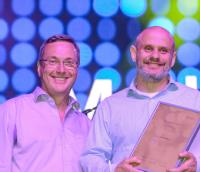
Congratulations to the brilliant Lucy Inman and Professor Mark Williams who both won a prestigious University Award last night.
 Lucy, who is Teaching and Learning Officer in the WMG Full-time Master's office won the top prize in the Service Excellence category.
Lucy, who is Teaching and Learning Officer in the WMG Full-time Master's office won the top prize in the Service Excellence category.
The judges said: “Lucy leads by example, bringing a calm and thoughtful approach to problems, working to resolve things to ensure the best possible outcome for students, and also putting measures in place to ensure it doesn’t repeat, or to mitigate the impact where matters
are likely to repeat."
Professor Mark Williams, who heads up the Metrology area at WMG, received the Research Contribution Award. “Through a passion for  knowledge and a nose for a great mystery, Mark is inspiring hundreds of people and answering age-old questions. He is a credit to Warwick and a
knowledge and a nose for a great mystery, Mark is inspiring hundreds of people and answering age-old questions. He is a credit to Warwick and a
perfect example of what can be achieved when people leave the confines of their main
area of research."
WMG’s involvement in the University’s Family Day was also recognised at the Awards, with the team scooping highly commended in the Community Contribution Award category.
The Warwick University Awards recognise outstanding individuals and teams from across the University. After the award ceremony staff enjoyed a special summer party with a festival theme including live music from Scouting for Girls.
Lord Bhattacharyya honoured by Beijing City University
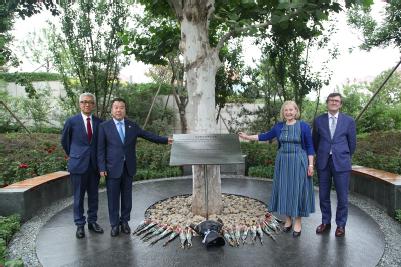 The President of Beijing City University (BCU) Liu Lin held a special memorial event, to celebrate the life of the late Lord Kumar Bhattacharyya, on Friday (21 June).
The President of Beijing City University (BCU) Liu Lin held a special memorial event, to celebrate the life of the late Lord Kumar Bhattacharyya, on Friday (21 June).
There was a special tree planted in his honour with Lady Bhattacharyya, and Professor David Mullins, Acting Head of WMG both present. David who worked closely with Professor Lord Bhattacharyya for over 20 years, also spoke at the event.
President Liu explained: “We have planted this tree to commemorate the late Lord Bhattacharyya. This tree symbolises the friendship between BCU and WMG, as well as the personal relationship which, like this tree, will last forever.”
Lady Bhattacharyya said: “It’s no exaggeration to say that Kumar loved China. He visited over forty times, beginning in the early 1980s.
“He was intensely proud of his role in the growth of the Chinese economy over three decades, building training and research partnerships with some of China’s most innovative businesses.”
In 2018, Lord Bhattacharyya was recognised by the Chinese government and presented with a China Talent Visa (R), in recognition of his high-level expertise in manufacturing and inward investment and sustained interaction with the People’s Republic of China.
He was one of the first recipients globally of the newly introduced R Visas for foreign talents awarded by the Chinese government, and was awarded with a ten-year visa. This follows Professor Lord Bhattacharyya receiving two prestigious awards from China – the Great Wall Friendship Award, from Beijing Municipal Government, and the Chinese Government Friendship Award, the premier national award, presented by the Vice-Premier at a special ceremony in Beijing on the occasion of the National Day.
The Chinese government, with this visa showed its sincerity towards global talent. It is awarded to foreign high-level personnel, and much-needed highly talented people, whose skills are in urgent demand to help the development of the economy and society of China.
Speaking at the event Lady Bhattacharyya, said: “It is fitting that today, we honour Kumar by planting a tree - a tree that will take root here in Beijing City University, and grow for years to come, giving life and comfort and shade to future generations, and watching over their progress.
“I hope that this tree will stand as a living reminder of Kumar’s faith in China, his belief in your people, and his hope for a clean, green, healthy, and prosperous future for us all.”
Celebrating International Women in Engineering Day
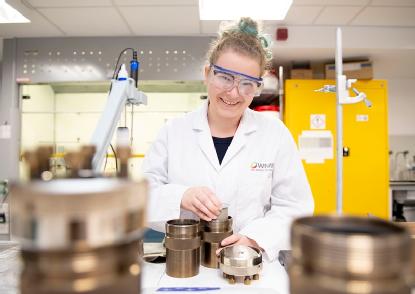 WMG is pleased to be helping the #TransformTheFuture campaign supporting International Women in Engineering Day this Sunday (23 June).
WMG is pleased to be helping the #TransformTheFuture campaign supporting International Women in Engineering Day this Sunday (23 June).
International Women in Engineering Day is an awareness campaign to raise the profile of women in engineering, and focuses attention on the amazing career opportunities available to girls in the industry.
In June, there will be a number of special events at WMG. On 25th June, Chemical Engineer Dr Katie Sizeland will be giving a talk to staff and students and sharing her career highlights and passion for science.
Katie is a Research Programme Manager at ANSTO investigating the nanostructure and mechanical properties of collagen using advanced imaging techniques and synchrotron-based small angle X-ray scattering (SAXS). She is one of only a few female X-ray scientists.
Inspiring young engineers
On 28th June, 58 girls from the WMG Academy for Young Engineers in Coventry and Solihull will be visiting WMG and taking part in a ‘People Like Me Session’ – “a WISE initiative and revolutionary approach to engaging girls with careers in Science, Technology, Engineering and Maths (STEM)”.
The day will be supported by some of WMG’s own inspiring women Eve Wheeler-Jones, Puja Unadkat, Jennie Murray, Lydia Adigun, Beth Haynes and Anisha Patel who will share their experiences of working in STEM.
WMG Women in STEM
At WMG there is a community of women working in STEM from teaching and technicians to researchers and project managers.
Professor Jan Godsell, who is a Chartered Engineer and Member of the IMechE; and has been appointed to advise the UK government on manufacturing policy as a member of the Department of Business, Innovation and Skills' Manufacturing Advisory Group, shares her career advice:
“Think big and grab the opportunities you are given. When I was in the sixth form I had the opportunity to attend an Insight programme to encourage Women into Engineering at Brunel University, which confirmed to me what I wanted to do. I’d also say keep your options open – going down the Mechanical Engineering route gave me very varied experiences.”
You can find out more about some of our inspiring women in STEM here.
